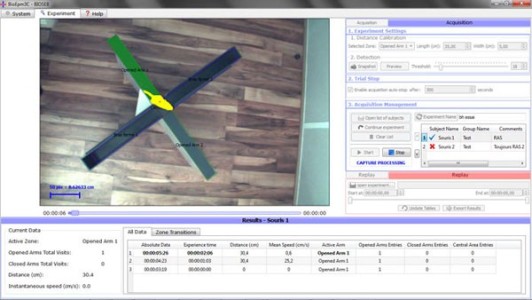Authors
Pham TH, Mendez-David I, Defaix C, Guiard BP, Tritschler L, David DJ, Gardier AM
Lab
Université Paris-Saclay, Univ. Paris-Sud, Faculté de Pharmacie, INSERM UMR-S 1178, Chatenay Malabry, 92290, France
Journal
Neuropharmacology.
Abstract
Unlike classic serotonergic antidepressant drugs, ketamine, an NMDA receptor antagonist, exhibits a rapid and persistent antidepressant (AD) activity, at sub-anaesthetic doses in treatment-resistant depressed patients and in preclinical studies in rodents. The mechanisms mediating this activity are unclear. Here, we assessed the role of the brain serotonergic system in the AD-like activity of an acute sub-anaesthetic ketamine dose. We compared ketamine and fluoxetine responses in several behavioral tests currently used to predict anxiolytic/antidepressant-like potential in rodents. We also measured their effects on extracellular serotonin levels [5-HT]ext in the medial prefrontal cortex (mPFCx) and brainstem dorsal raphe nucleus (DRN), a serotonergic nucleus involved in emotional behavior, and on 5-HT cell firing in the DRN in highly anxious BALB/cJ mice. Ketamine (10 mg/kg i.p.) had no anxiolytic-like effect, but displayed a long lasting AD-like activity, i.e., 24 h post-administration, compared to fluoxetine (18 mg/kg i.p.). Ketamine (144%) and fluoxetine (171%) increased mPFCx [5-HT]ext compared to vehicle. Ketamine-induced AD-like effect was abolished by a tryptophan hydroxylase inhibitor, para-chlorophenylalanine (PCPA) pointing out the role of the 5-HT system in its behavioral activity. Interestingly, increase in cortical [5-HT]ext following intra-mPFCx ketamine bilateral injection (0.25 μg/side) was correlated with its AD-like activity as measured on swimming duration in the FST in the same mice. Furthermore, pre-treatment with a selective AMPA receptor antagonist (intra-DRN NBQX) blunted the effects of intra-mPFCx ketamine on both the swimming duration in the FST and mPFCx [5-HT]ext suggesting that the AD-like activity of ketamine required activation of DRN AMPA receptors and recruited the prefrontal cortex/brainstem DRN neural circuit in BALB/c mice. These results confirm a key role of cortical 5-HT release in ketamine's AD-like activity following the blockade of glutamatergic NMDA receptors. Tight interactions between mPFCx glutamatergic and serotonergic systems may explain the differences in this activity between ketamine and fluoxetine in vivo.
BIOSEB Instruments Used
Elevated Plus Maze : EPM3C - 3 clicks only ! (BIO-EPM3C)
Source :

 Douleur - Allodynie/Hyperalgésie Thermique
Douleur - Allodynie/Hyperalgésie Thermique Douleur - Spontanée - Déficit de Posture
Douleur - Spontanée - Déficit de Posture Douleur - Allodynie/Hyperalgésie Mécanique
Douleur - Allodynie/Hyperalgésie Mécanique Apprentissage/Mémoire - Attention - Addiction
Apprentissage/Mémoire - Attention - Addiction Physiologie & Recherche Respiratoire
Physiologie & Recherche Respiratoire




































 Douleur
Douleur Système Nerveux Central (SNC)
Système Nerveux Central (SNC)  Neurodégénérescence
Neurodégénérescence Système sensoriel
Système sensoriel Système moteur
Système moteur Troubles de l'humeur
Troubles de l'humeur Autres pathologies
Autres pathologies Système musculaire
Système musculaire Articulations
Articulations Métabolisme
Métabolisme Thématiques transversales
Thématiques transversales Congrès & Meetings
Congrès & Meetings 